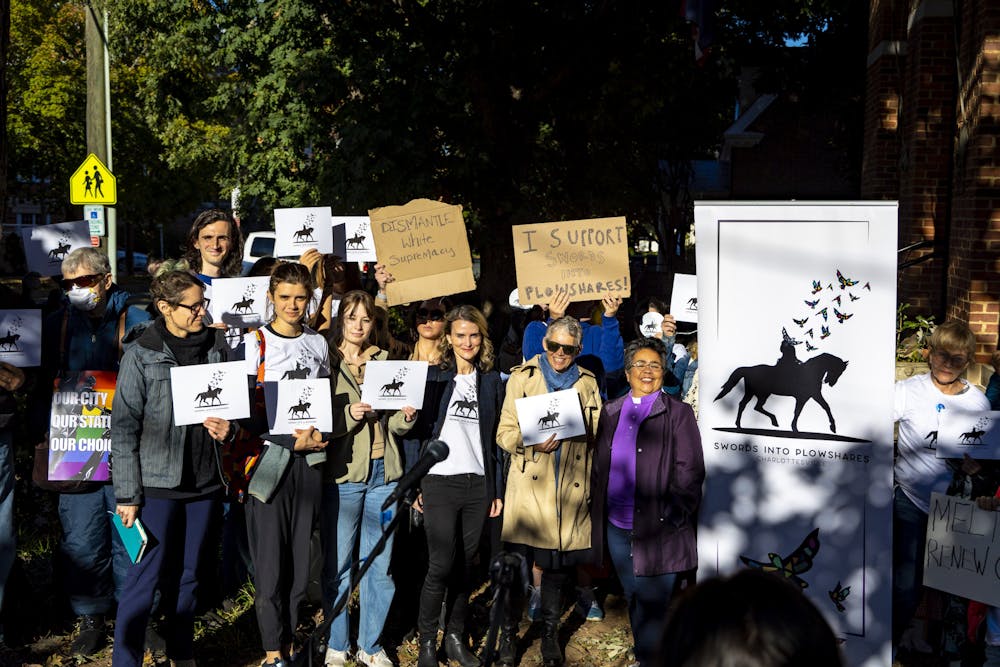Swords into Plowshares, an ongoing project by community leaders to melt down and repurpose the Robert E. Lee statue, has reached a major milestone — two weeks ago, the statue was cleaved and its parts were melted down. The metal will be transformed into a new piece of public art. The Lee statue has had a significant impact on Charlottesville — unveiled to honor the Confederate general in 1924, it served as a symbol for neo-Nazis and white supremacists to gather around in 2017 during the ‘Unite the Right’ rally. In fact, the rally was held to protect the statue, which the Charlottesville City Council had, at the time, considered removing from its place in Market Street Park. The Lee statue was eventually removed in 2021 and, after more than a year of litigation, it finally faced the flames just a couple of weeks ago.
Removing the statue is significant in and of itself, and melting down the statue to repurpose its metal signifies the capacity we have as a community to communicate our values and continue the process of creating our history. The repurposing of the Lee statue into a piece of public art that reflects the commitments of today's Charlottesville residents should be used as a guide for the University — let this be an example of one way our institution can continue to reckon with how its problematic history continues to impact students, faculty, staff and the broader Charlottesville community.
Repurposing the Lee statue, a once proud reminder of the Confederacy, is cause for celebration. The Editorial Board applauds all of the advocacy, hard work and community-building that made this repurposing a reality. Turning the Lee statue into a new object does not just “move history forward” as SIP’s proposal highlights — this symbolic act allows the Lee statue, which was erected to disempower and silence people, to be reclaimed as a symbol of inclusion and empowerment by those same communities the statue initially sought to disenfranchise. SIP’s success enriches the history of our historic community by demonstrating how public spaces can serve as centers of social change.
Many, however, do not support the Lee statue’s repurposing. It has been said time and time again that removing confederate statues erases our nation’s history and culture, suggesting that — by removing these symbols of hatred — we are doing something deeply un-American. This could not be further from the truth. In 1776, the year our nation was founded, colonists tore down a statue of King George III, melted it and repurposed the structure into musket balls to use in the Revolutionary War. History shows us that there are few things more American than leveraging symbolism and a community’s commitment to a shared set of values to fight for independence and recognition. It is not un-American to try and ensure that the space we inhabit and the objects we display accurately represent the things we believe in. To call the tearing down and repurposing of Confederate monuments un-American is to stagnate the country and its values.
The logic used to justify repurposing historical symbols of oppression should be applied here on Grounds — not to erase our history, but rather to move it forward. It is easy for people to shrug their shoulders when looking around Grounds and think that the removal of certain names and symbols amounts to erasing our community’s history. But when names were first placed on buildings and memorials were initially constructed around Grounds the goal was not to honor history. The racists and eugenicists who once led the University were intentional about which people and what values they enshrined within our community. As the University continues to change and evolve, our values and ideals evolve with it. Accepting what was left on buildings, in parks and in cities many decades ago is a betrayal of the precedent set when these namesakes and symbols were first chosen — a precedent wherein people were acutely aware of the power that lies within the figures we choose to memorialize.
Our job is not to simply inherit the world we are given — rather, we must think critically about why certain statues were erected and specific names attached and how these symbols are perceived by the community that is forced to interact with them today. Charlottesville’s history does not stop at Edwin Alderman, Joseph Cabell or Robert E. Lee. It continues with us — as students and community members continue to advocate for Charlottesville more broadly, let SIP and similar local efforts serve as a reminder that history is not stagnant. Neither are we. The narrative is changing. Much like previous generations took a stand when they constructed their statues and chose their namesakes — let us speak for ourselves, with new art, new building names and a renewed appreciation for the power that lies in the symbols we select.
The Cavalier Daily Editorial Board is composed of the Executive Editor, the Editor-in-Chief, the two Opinion Editors, their Senior Associates and an Opinion Columnist. The board can be reached at eb@cavalierdaily.com.







